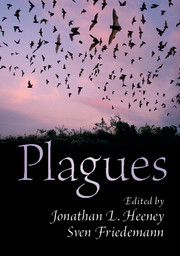Book contents
- Frontmatter
- Dedication
- Contents
- List of Figures
- List of Tables
- Notes on Contributors
- Foreword
- Preface
- Acknowledgements
- 1 Ebola: The Plague of 2014/2015
- 2 Plagues and History: From the Black Death to Alzheimer's Disease
- 3 Plagues and Medicine
- 4 The Nature of Plagues 2013–14: A Year of Living Dangerously
- 5 Plagues, Populations and Survival
- 6 Plagues and Socioeconomic Collapse
- 7 Silicon Plagues
- 8 The Human Plague
- 9 Plague as Metaphor
- Index
- References
8 - The Human Plague
Published online by Cambridge University Press: 24 March 2017
- Frontmatter
- Dedication
- Contents
- List of Figures
- List of Tables
- Notes on Contributors
- Foreword
- Preface
- Acknowledgements
- 1 Ebola: The Plague of 2014/2015
- 2 Plagues and History: From the Black Death to Alzheimer's Disease
- 3 Plagues and Medicine
- 4 The Nature of Plagues 2013–14: A Year of Living Dangerously
- 5 Plagues, Populations and Survival
- 6 Plagues and Socioeconomic Collapse
- 7 Silicon Plagues
- 8 The Human Plague
- 9 Plague as Metaphor
- Index
- References
Summary
It is now beyond reasonable doubt that we are the drivers of almost every global problem we face and that every one of these problems is set to grow, as we continue to grow., Can we say that humans constitute a ‘plague’. Well, it turns out that this is not too ridiculous a comparison to make. The term ‘plague’ is thought to originate from the Latin plāga (‘blow’), or what we would now call an ‘infection’ of a host by disease-causing agents. This includes the rapid multiplication of such organisms and their actions on the host, and the reaction of the host to these organisms and the toxins they produce. I argue the analogous case; that we humans are agents who, through our rapid multiplication and our actions, are now starting to have a deleterious impact on our host, our planet. As a consequence, there is now an emerging reaction of our host to us and our actions.
Just over 200 years ago, there were fewer than a billion humans living on Earth. When I was born in 1960, there were three billion. In 2015, the human population has more than doubled to over seven billion people, and the UN projections expect that there will be ten billion humans on earth sometime towards the end of this century. This is if, optimistically, fertility rates continue to decline as they have done over the last fifty years. It is worth mentioning that this fifty-year decline in fertility rate, which many are keen to point out as a counter-claim to the argument that we have a problem, is actually slowing. It is also worth highlighting that if the current fertility rate were to continue unchanged (which the United Nations defines as the ‘constant fertility variant’), the global population at the end of this century would not be ten billion people, but will be twenty-eight billion.
With this in mind, I should point out that the UN population statistics have been systematically revised upwards over the past decade. The ‘peak’ population under the ‘expected scenario’ in 2100 was under ten billion. It is now over 11 billion according to estimates at the time of writing (Figure 8.1).
- Type
- Chapter
- Information
- Plagues , pp. 184 - 195Publisher: Cambridge University PressPrint publication year: 2017

